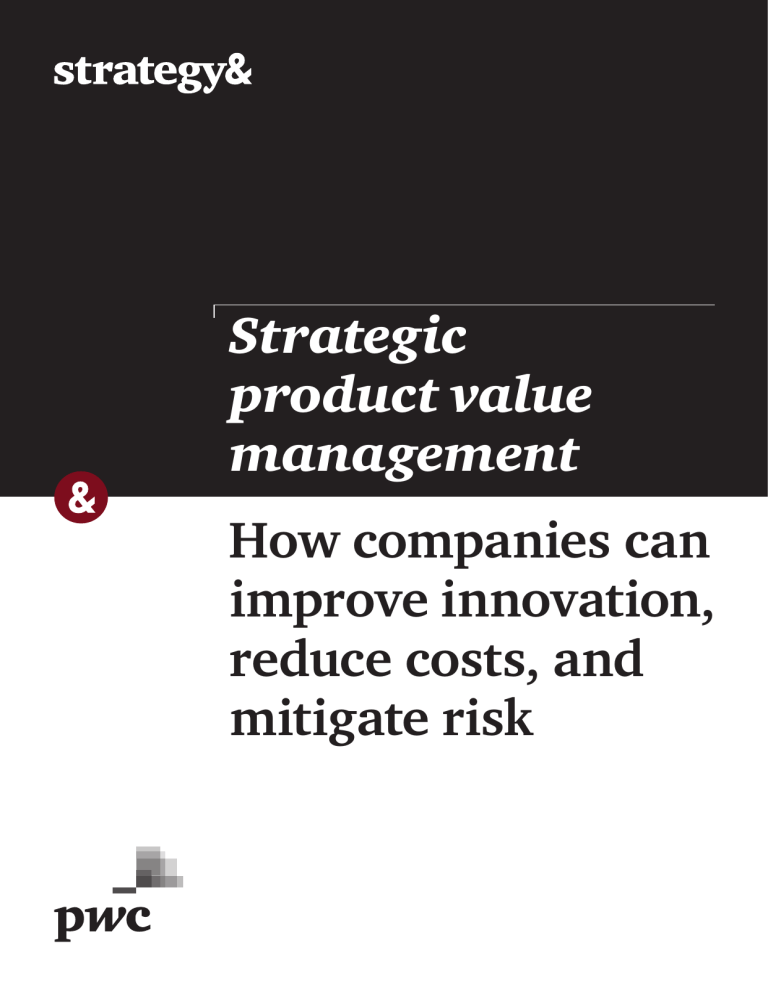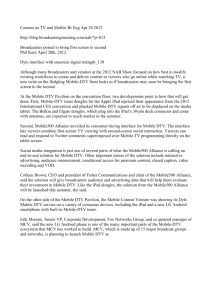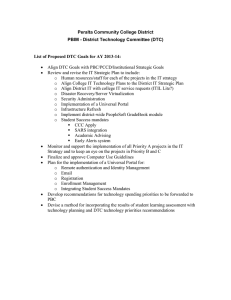How companies can improve innovation, reduce costs, and mitigate

Strategic product value management
How companies can improve innovation, reduce costs, and mitigate risk
Contacts
Chicago
Eric Dustman
Principal
+1-312-578-4740 eric.dustman
@strategyand.pwc.com
Volker Staack
Principal
+1-617-763-1040 volker.staack
@strategyand.pwc.com
Emmanuel Legbeti
Director
+1-312-613-0377 emmanuel.legbeti
@strategyand.pwc.com
Reinhard Moebius
Director
+1-248-890-9114 reinhard.moebius
@strategyand.pwc.com
Cleveland
K.B. Clausen
Director
+1-216-696-1737 kb.clausen
@strategyand.pwc.com
DC
Brad Goehle
Director
+1-973-410-7664 brad.goehle
@strategyand.pwc.com
Düsseldorf
Oliver Bollmann
Principal
+49-211-5300-131 oliver.bollmann
@strategyand.pwc.com
Christian Foltz
Principal
+49-211-5300-131 christian.foltz
@strategyand.pwc.com
Sascha Schuth
Managing Director
+49-211-542416-120 sascha.schuth
@strategyand.pwc.com
Florham Park
Albert Kent
Principal
+1-973-410-7660 albert.kent
@strategyand.pwc.com
About the authors
Volker Staack is a principal with
Strategy& based in Chicago, and a senior leader of the firm’s innovation practice. He works with automotive, industrial, and technology companies, helping them build competitive innovation capabilities from strategy to execution, improve new product development efficiency and effectiveness, and increase strategic product value.
Reinhard Moebius is a director with Strategy& based in Chicago, and a co-leader of the firm’s innovation practice. He brings deep experience with industrial innovation, having worked in product development and R&D in the automotive sector, where he applied the principles of design to value and design to cost.
2 Strategy&
Executive summary
Strategy&
In a global economy characterized by growing competition, even market leaders struggle to achieve target growth rates through innovation. As cost pressures increase, companies have begun spending less on incremental innovation (modest advances to existing products and services) and allocating more of their declining research and development budgets to breakthrough innovation (bolder moves to develop radically different products and services). However, breakthrough innovation carries substantial risks. As a result, companies require a unique set of capabilities — which we refer to as strategic product value management — to manage these risks, reduce product costs, drive growth, and expand margins.
Strategic product value management uses commercial and design levers to provide the discipline and methodology required to manage risks during product development. It adds significant value early in the process, particularly through two aspects: design to value (DTV) and design to cost (DTC). Design to value entails analyzing what customers need in terms of features, efficacy, or other attributes
(i.e., the value proposition of a particular product, including pricing).
Design to cost, by contrast, entails analyzing all costs of a particular product and developing rigorous models to reduce those costs at every possible juncture.
Many companies currently apply some form of DTV or DTC, yet they typically use one or the other, and in isolation. We believe the biggest opportunity to reduce costs, drive growth, expand margins, and manage risks is to apply both approaches in parallel early in the product development process. In addition, these methods need to be applied repeatedly at each design iteration — not just during initial development but throughout the product life cycle — so that the cost and pricing models become more refined and accurate over time.
3
The challenge of growth through innovation
In virtually all industries, smart companies seek to grow organically through innovation. But many are simply not good at it. Each year for the past decade, Strategy& has conducted a systematic study of innovation at multinational companies. A core finding of that research — across 10,000 statistical analyses — is that there is almost no correlation between an organization’s R&D spending and its financial performance. (See Barry Jaruzelski, Volker Staack, and Brad Goehle, “The Global Innovation 1000: Proven Paths to
Innovation Success,” strategy+business, Winter 2014.)
Our research breaks innovation down into three principal models:
• Need seekers, such as Apple, Procter & Gamble, and Tesla, use superior insights about their customers to generate new product ideas.
• Market readers, such as Samsung, Caterpillar, and Visteon, create value through incremental innovations to products that have already proven their worth in the market. This is a more cautious, “fast-follower” approach, and it involves closely monitoring specific markets, customer segments, and competitors.
• Technology drivers, such as Google, Bosch, and Siemens, depend heavily on their internal technological capabilities to develop new products and services. They apply an inside-out approach, developing products of superior technological value and expecting that their discoveries will meet the known and unknown needs of their customers.
Although all three models can work, our research indicates that the need seeker model is the most consistently successful. In our
10-year analysis, need seekers are more likely to show stronger financial performance than their competitors, and they are more likely to align their innovation strategy with their overall business strategy.
4 Strategy&
More broadly, the challenge of successful innovation and new product development is becoming more difficult. Companies are now spending a smaller amount on incremental innovation as a percentage of overall revenue, and shifting a greater percentage of that investment to breakthrough ideas. They are essentially making bigger bets in order to give themselves a true competitive edge. Although such moves have the potential for larger payoffs, they also entail correspondingly larger risks.
These market dynamics are not going away. Innovation is an ongoing imperative, and as companies make increasingly large bets on breakthrough innovation, the risks will only grow. To meet this challenge, companies need to effectively manage the inherent risks — ideally as early as possible in the development process for products and services. At first glance, risk management may seem to run counter to the idea of breakthrough innovation, because innovators should theoretically be freed from any constraints and allowed to dream big.
In fact, however, the opposite is true. The ability to effectively manage risks has a direct correlation with a company’s innovation success. It keeps the innovators focused on aligning their product or service with the customer’s true needs, rather than just innovation for its own sake.
In this way, risk management is akin to guardrails that establish the true boundaries for innovation and ensure that the resulting products or services link to the organization’s overall strategy and fulfill their mandate of creating value for customers.
Strategy& 5
Strategic product value management
6
Managing these risks requires discipline and a robust methodology, which we refer to as strategic product value management. Strategic product value management is a comprehensive means to connect a company’s portfolio strategy to execution. Companies that apply this methodology utilize commercial and design levers to determine the ideal portfolio of products, develop detailed cost models for those products, and rigorously reduce their costs at all steps along the value chain.
In this way, strategic product value management provides the discipline and methodology that companies need to manage risks during product development. Yet the most powerful levers of the methodology apply early in the design process. It is at this initial step that many companies go wrong, burning through significant time and capital on products without an explicit understanding of specific features that the customer wants — articulated or unarticulated — or, more critically, a sense of what those customers will pay for such features.
Two aspects of the methodology can help companies avoid these issues: design to value (DTV) and design to cost (DTC). In essence, design to value entails analyzing what customers need in terms of features, efficacy, or other attributes (i.e., the value proposition of a particular product, including pricing). Design to cost, by contrast, entails analyzing all costs of a particular product and developing rigorous models to reduce those costs at every possible juncture (see Exhibits 1,
next page, and 2, page 8). A company needs both approaches to accurately determine which design features will add real value for customers and which will not, and how much those features will affect pricing. By applying these tools early in the process — and iteratively — companies can avoid irreparable mistakes at the outset and refine their value analysis over time.
Strategic product value management is a comprehensive means to connect a company’s portfolio strategy to execution.
Design to value
Design to value (DTV) is a capability by which companies assess the value proposition of a particular product, ideally as early as possible
Strategy&
Exhibit 1
Strategic product value management generates top- and bottom-line value throughout the product life cycle
Top-line growth
– Markets
– Features
– Products
– Customer segmentation
Product life cycle
Strategic cost management
Design to value
Design to cost
Bottom-line growth
– Design
– Material
– Process
Delivery
Cost road map Cost tracking
Source: Strategy& analysis during the development or refresh process, and create a competitive advantage by identifying new product derivatives, features, and/or configurations (e.g., for specific customer segments). DTV is most often applied throughout the product life cycle in industries and product categories where features are still evolving in response to rapidly changing needs among customers.
Critical to DTV is a detailed understanding of the customer’s problems and needs. What are the product features or attributes that a customer really wants? What is the competition’s value proposition? How much value does each feature represent to the customer? How do those elements affect pricing for the product? And what is the potential impact of product complexity to the overall supply chain cost?
Accordingly, DTV typically requires mechanisms to understand the voice of the customer, such as customer clinics, focus groups, consumer research, conjoint analysis, and other means of capturing market insights. It includes assessing the trade-offs that customers are willing to make between, for example, the lead time for new orders and more customized offerings.
Strategy& 7
Exhibit 2
Design to value and design to cost are iterative processes that optimize perceived customer value and product cost
Design to value vs. design to cost process overview
1.
Initialization
Design to value (DTV)
– Identify focus for initiative and competitive products for teardown
– Review bill of materials (BoM), requirements, and specifications
– Perform product teardown
– Review historical financial baseline and cost tree breakdown
2A.
Customer segment requirements and value
2B.
Profitability assessment
– Define segment needs, value drivers, and buying behaviors
– Determine customer perception and willingness to pay
– Establish system-level/feature target costs, and break down purpose and value of product functions
3.
Bottom-up cost calculation
4.
Identify, evaluate, and approve
DTV/DTC concepts
5.
Review DTV/DTC road map
Design to cost (DTC)
– Collect specifications and technical drawings
– Review BoM
– Assess cost gap to benchmarks and reduction potential, based on function, on a historical pro forma basis
– Identify cost drivers (e.g., process, material, features, design, manufacturing location) and/or revenue drivers
– Develop high-level cost estimate of competitive system
– Review functionality, performance, and competitor designs
– Perform deep-dive profitability analysis for product in scope
– Derive target cost
– Identify cost drivers (e.g., process, material, features, design, manufacturing location)
– Facilitate workshops with cross-functional teams and suppliers to generate ideas and/or discuss how to realize ideas
– Assess high-level impact of ideas on performance and costs
– Prioritize ideas based on historical pro forma impact, risk, and viability
– Define a qualitative road map
– Document clear time sequencing of the different design concepts
– Define dependencies
– Define potential levers
Source: Strategy& analysis
8 Strategy&
DTV also requires identifying and managing product cost drivers, such as raw materials, manufacturing, and distribution, so that the corresponding cost and price models are objective, fact-based, and accurate. The challenge lies not merely in assessing the cost — and desirability — of new features, but in developing a process to capture second-order effects, such as relationships between the price of the new product or service and the corresponding volume increase or decrease, which in turn affect pricing. For example, some features may involve expensive electronic components, but if those features are attractive enough, they will increase overall sales volume, thus reducing the price of the components over time through scale effects. This kind of volume and price sensitivity analysis, together with disciplined reviews of each design iteration throughout the new product introduction process, can significantly affect the business case for the new product, but only if the underlying analysis has rigor.
DTV also helps companies optimize efficiency in product design and manufacturing by highlighting areas for improvement. Typical activities include the following:
• “Teardowns,” in which companies disassemble key products alongside those of their competitors to document technical and functional differences and identify strategies for reducing costs or optimizing features
• Clean-sheet modeling, which involves determining the detailed
“should cost” for each product and developing strategies to reduce expenses, either by redesigning products or processes or by negotiating with suppliers to improve procurement costs
• Demand analytics, using various approaches to model customer purchase behavior, competitive response, and market share for a range of product-price value propositions
• Compiling and prioritizing a list of specific and pragmatic ideas that companies can implement to increase customer value while reducing product costs
Design to cost
Unlike design to value, which focuses on all levers to optimize the value proposition of a particular product, design to cost looks solely at reducing costs (and potentially price). This is critical in managing the costs and risks of new product development, since a substantial portion of a product’s cost is directly linked to its design. DTC treats the overall target cost as an independent — and nonnegotiable — design parameter
Strategy& 9
that the company must achieve. It is most commonly applied in mature industries, where product features are essentially settled and where companies can gain a competitive advantage primarily through pricing.
DTC involves specific methodologies to determine the drivers of cost in product design — in raw materials, the manufacturing process, and components, among others — and then systematically reduce those costs, as early in the design process as possible. Companies employ various approaches to model product costs, yet those methodologies can vary in speed and accuracy. We believe the best approach is processdriven and bottom-up. In this approach, the entire value chain is broken down into discrete steps and modeled on benchmark machining and manufacturing standards. It considers key input parameters, such as the manufacturing country, energy and labor costs, raw material costs, and required square footage, to determine a cost model for the product under ideal conditions.
At that point, the company can start determining how to improve cost drivers at each step in order to close the gap. Short-term options address the supply chain (for example, seeking to reduce the costs of materials), and longer-term and more comprehensive options focus on design and manufacturing processes (changing the way the company manipulates those materials). Ideally, the company applies all technical and commercial levers to reduce costs, and it develops road maps to manage the improvement process over time.
10 Strategy&
Three core capabilities
Both the design-to-cost and design-to-value approaches require developing three specific capabilities:
1. An organizational structure that ensures that strategic product value management is being applied rigorously in the most effective way throughout the company. This structure needs to balance formal elements and informal elements (including culture) in a crossfunctional manner, with clearly defined roles and responsibilities.
2. A comprehensive analytics function that allows the company to understand product demand, customer affordability, and product cost drivers. The analytics function needs to designate target costs as precisely as possible, including methods such as activity-based cost allocation.
3. An integrated product value management process, including robust design and manufacturing engineering capabilities. The right process involves the following:
The goal of stable, consistent cost requirements in order to avoid
“creeping elegance” (the tendency for engineers and designers to add more advanced features during the design process, making the product more costly than necessary)
Incorporating design-for-manufacturability principles, which can significantly reduce costs by considering production during the design phase
The ability to tear down competitors’ products in order to analyze the constituent costs and functional components
Applying continuous improvement principles through value engineering to improve the product’s value over the long term
Strategy& 11
A powerful combination
Both DTV and DTC are well known and currently used in highly competitive, process-driven industries like automotive, consumer goods, and others that require significant product design. However, most organizations still see both processes as sequential and with little overlap. The dramatic increase in global competition requires organizations to use these tools in a more effective manner. We believe the biggest opportunity to reduce costs and manage risks is to apply both approaches in parallel, early in the product development process.
In addition, they need to be applied repeatedly at each design iteration throughout the product life cycle, so that the cost and pricing models become more refined and accurate over time (see case study, page 14).
In the idea phase of a project, cost estimates will often be very rough, since few product specifications have been nailed down and companies are working largely with assumptions. At that point, high-level cost models can provide enough directional guidance to help companies make decisions to move forward, before specifications get locked down and reversing or correcting the decision becomes cost-prohibitive.
As the design solution matures, so will the cost model, and the estimates will be more precise.
There are multiple reasons that organizations struggle to implement strategic value management. Among the most common are a lack of cross-functionality within the team and a lack of overall leadership.
In addition, though many companies apply DTC techniques during the development phase, they don’t enhance that analysis with DTV techniques to incorporate customer input regarding required features and — critically — the value that such features might generate. Some organizations are simply too distant from their actual customers to completely understand customer expectations, buying segments, and the trade-offs between lead time and customization. Most challenging is the link between incremental sales and specific features, as this requires deep customer understanding and commitment from the sales organization.
The dramatic increase in global competition requires organizations to use DTV and
DTC in a more effective manner.
12 Strategy&
Risks and benefits
The challenge in the strategic product value management process is usually a lack of the rigor and discipline required to drive costs out. The initial assumptions that many companies make at the outset regarding product development and production costs are frequently inaccurate.
And companies tend to underestimate shrinkage during the process due to inevitable trade-offs.
However, the potential gains from applying a systematic approach for managing risks are greater at the beginning of the process. Achievable cost reductions from strategic product value management vary based on volume, industry, and the regulatory environment. In the automotive industry, for example, achievable cost savings range from 15 to 20 percent. Organizations that have a strong mechanical engineering heritage and are shifting to integrated electronic systems can usually realize greater cost savings in those noncore systems. It is important to understand that strategic product value management is an ongoing process that runs throughout a product’s life cycle and doesn’t stop until the product becomes obsolete.
Strategic product value management is an ongoing process that runs throughout a product’s life cycle and doesn’t stop until the product becomes obsolete.
Cross-functional collaboration
Though DTV and DTC activities are often driven by engineering or research and development departments, it is imperative not to overlook the importance of cross-functional team collaboration. Successful companies engage sourcing, sales, marketing, and finance early in the product development process to ensure better alignment, leverage analytical capabilities to model supplier economics, consider supply source (or realistic alternatives), and simply execute more effectively.
Cross-functional teams can also take preventive actions early on to avoid costly supply chain surprises downstream. Early cross-functional engagement is an important criterion that enhances the likelihood that ideas will make their way to implementation.
Strategy& 13
Case study: DTV, DTC, and new product development
A manufacturer of agricultural products wanted to sell a low-cost device for spreading seeds in several rapidly growing emerging markets. The manufacturer already had a seeder that sold well in developed markets, but a cost analysis found that it was simply too expensive for emerging markets, with production costs that were approximately five times higher than those of competitors’ offerings. That difference was too big to simply adapt the existing product — by stripping out features to reduce costs, for example.
Instead, the manufacturer would need to develop a new seeder at dramatically lower costs. Additionally, it had to reduce costs while ensuring that the final product still represented the company’s brand and DNA. To meet this challenge, the company used DTV and DTC methodologies.
The product team started by analyzing customer demands, talking to farmers in its target markets to understand the features they wanted, their price and usage expectations, and other product life expectations. That DTV analysis gave the company a clear set of performance criteria and features it would need to include at a defined target price. Using that data, the company developed a high-level set of product requirements, including target cost.
The company also purchased several low-cost seeders already being sold in those markets, tested them on its own fields against the customers’ criteria, and compared them with product requirements for the target market.
Engineers then conducted a teardown analysis, in which they disassembled the competitors’ units to their individual components, and developed a bottomup cost model. They reverse-engineered each system along the entire supply chain to develop a clear understanding of the cost drivers for components and systems.
Next, the company conducted an intense, one-week, cross-functional offsite meeting with representatives from procurement, marketing, engineering, and manufacturing, among others. At that offsite, the team researched the market requirements for individual target countries and translated them into product requirements. It then identified and refined the product design that best met those requirements, including the target cost, thanks to the use of certain components made from plastic and other materials instead of the metal parts used in higher-end seeders. As a result, the company moved into the formal product development process with a clear path that significantly reduced the risk of missing targets early in the process. A year later, the seeder was in production.
Even more important, the company now has a strong capability in new product development — including DTC and
DTV — which it can use to manage the risk of innovation early in the product development process.
14 Strategy&
Conclusion
Whether in new ventures or in a corporate setting, what drives innovation forward is the ability to identify, prioritize, and systematically manage risks. The strategic product value management process provides a robust framework to manage risks throughout the innovation process along the product life cycle. Success requires developing three capabilities: an organizational structure that supports DTV and DTC; robust analytics to understand customer demand and price sensitivity as well as product cost drivers; and a cross-functional approach.
Implemented correctly, this methodology does not limit creativity, but rather puts in place a structure that helps companies focus on the innovations that promise the highest return on investment.
Strategy& 15
Strategy& is a global team of practical strategists committed to helping you seize essential advantage.
We do that by working alongside you to solve your toughest problems and helping you capture your greatest opportunities.
These are complex and high-stakes undertakings
— often game-changing transformations. We bring
100 years of strategy consulting experience and the unrivaled industry and functional capabilities of the PwC network to the task. Whether you’re charting your corporate strategy, transforming a function or business unit, or building critical capabilities, we’ll help you create the value you’re looking for with speed, confidence, and impact.
We are part of the PwC network of firms in 157 countries with more than
195,000 people committed to delivering quality in assurance, tax, and advisory services. Tell us what matters to you and find out more by visiting us at strategyand.pwc.com.
www.strategyand.pwc.com
© 2015 PwC. All rights reserved. PwC refers to the PwC network and/or one or more of its member firms, each of which is a separate legal entity. Please see www.pwc.com/structure for further details. Disclaimer: This content is for general information purposes only, and should not be used as a substitute for consultation with professional advisors.




